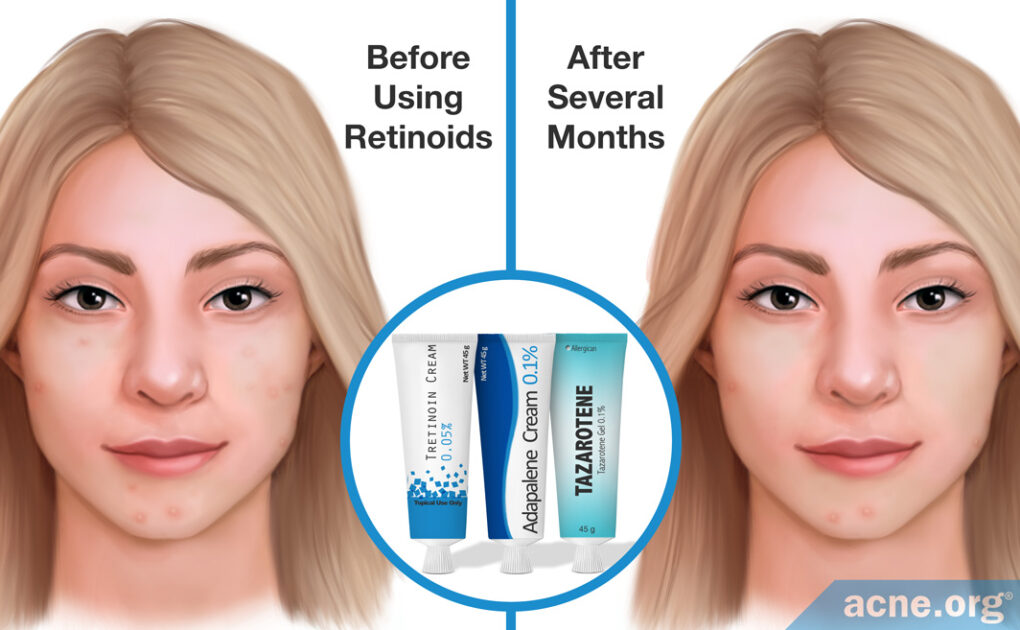Yes, Topical Retinoids (Tretinoin, Adapalene, Tazarotene, and Probably Trifarotene) Reduce the Appearance of Skin Aging by Promoting Renewal of the Skin, Helping to Reverse Sun Damage, and Promoting the Production of the Important Skin Protein, Collagen

The Essential Info
There are 4 topical retinoids that doctors commonly prescribe for their ability to unclog pores and reduce inflammation, thus reducing acne symptoms:
- Tretinoin
- Adapalene
- Tazarotene
- Trifarotene
All of these medications reduce acne to a moderate degree. However, as a bonus, they also fight the signs of aging by:
- Keeping the skin turning over
- Protecting against sun damage
- Increasing in the amount of collagen in the skin
This all sounds great, but there are two things to be aware of:
- Results are temporary: As soon as you stop using any of the retinoids, any anti-aging benefit you received will quickly fade.
- Retinoids only partially clear acne: They must be combined with other medications, notably benzoyl peroxide, to achieve desired results.
Still, if you are looking for an acne treatment and an anti-aging treatment at the same time, retinoids can give you that one-two punch.
My Experience: As soon as I started seeing doctors for my acne, they were throwing retinoids at me left and right. Retinoids are the go-to prescriptions for acne. However, I was always disappointed in their results. It turns out they only improve acne by about 50%, which in my opinion is unacceptable. Who wants to go from 20 zits at a time to 10? If I only had very light acne and wanted slightly less wrinkles and an increased “glow,” retinoids might have been a good option, but for my actual, real acne condition, they felt a bit like a drop in the bucket.

The Science
- How Retinoids Work
- The Effectiveness of Topical Retinoids Against Skin Aging
- Limitation of Retinoid Therapy
- Side Effects of Retinoid Treatment
Retinoids are derivatives of vitamin A. As far back as 3000 years ago, Egyptians used vitamin A from rat livers to treat various health problems. In the early 20th century, scientists confirmed the necessity of vitamin A in normal skin health and appearance. And by 1968, chemists began developing synthetic topical vitamin A derivatives, called retinoids, which were relatively safe and reliably improved skin appearance, and reduced acne symptoms.
Scientists first developed the retinoid called tretinoin. However, today there are 4 major retinoids that doctors prescribe for acne:
- Tretinoin
- Adapalene
- Tazarotene
- Trifarotene (This is a newcomer to the market, so there is very little research on it. Scientists theorize that trifarotene may have anti-aging characteristics similar to other retinoids, but more research is needed.1 For the rest of this article, I will be talking only about the first 3 retinoids, which have a lot more data for us to draw on.)
Soon after tretinoin hit the market, female patients began reporting changes in the appearance of their skin, noting fewer wrinkles and smoother skin after undergoing retinoid treatment. Following these reports, scientists conducted studies in mice and in humans and concluded that topical retinoids do indeed decrease signs of aging, including sun damage, abnormal pigmentation, and skin growths.2,3
How Retinoids Work
Retinoids reduce acne, on average, by about 50%. However, they also fight the signs of aging through:
- Enhancing the renewal of skin cells
- Protection against sun damage
- Increasing in the amount of a skin protein called collagen
Let’s take a closer look at each of these one by one.
Renewal of skin layers
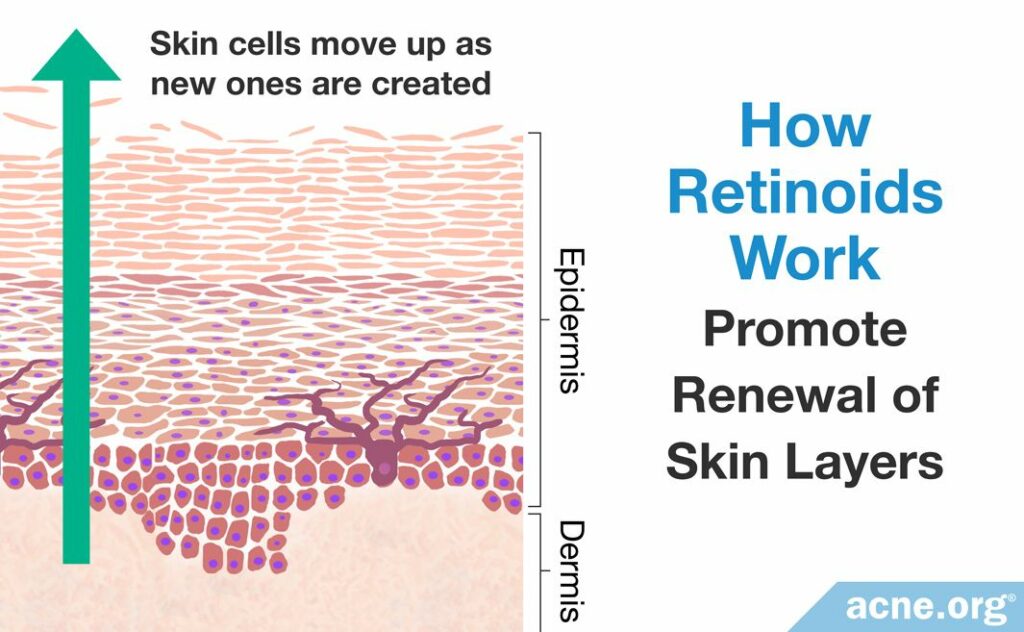
The skin consists of layers that work together to create a barrier for the body. The skin barrier is tough but pliable, and is constantly renewing itself in order to keep the barrier strong.
Vitamin A is essential for skin renewal. Retinoids naturally occur in the skin, and the presence of these retinoids affects the skin’s ability to undergo its natural turnover and renewal process, which is especially important to promote a healthy, strong skin barrier after a skin injury or wound.4,5
Protection against sun damage
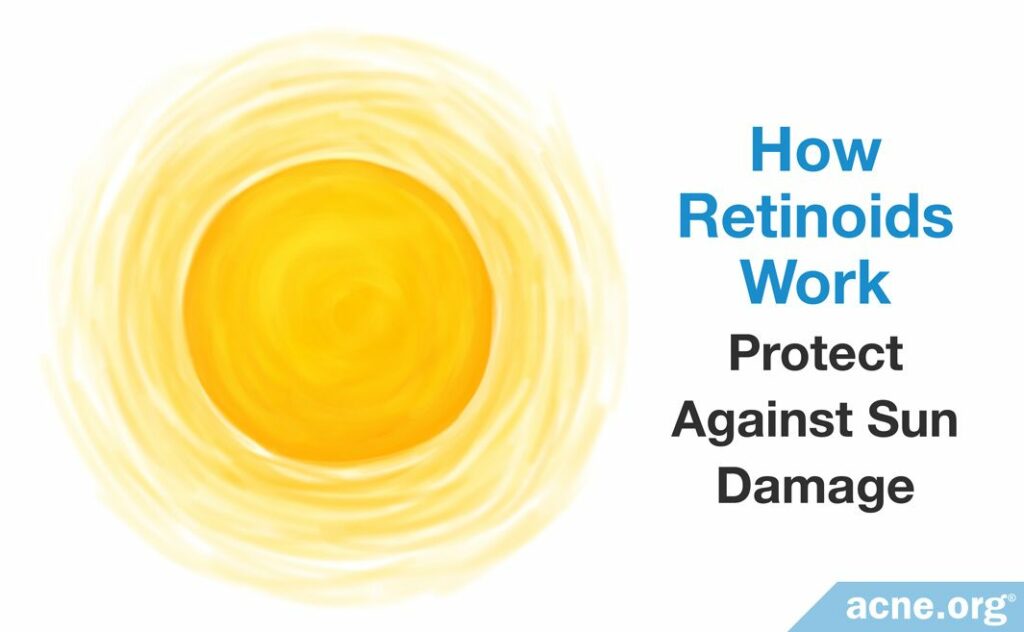
Each day that we go outside, the skin’s barrier is exposed to the sun and pelted with ultraviolet (UV) radiation. This exposure can cause the skin to become rough, uneven, and abnormally pigmented.3
Scientists have shown that “retinoids may counteract some deleterious actions of UV radiation…”4 In much the same way that vitamin A promotes natural skin renewal, retinoids promote healing of sun-damaged skin by decreasing wrinkles, improving skin texture, and clearing abnormal pigmentation.6
Increase in the amount of collagen
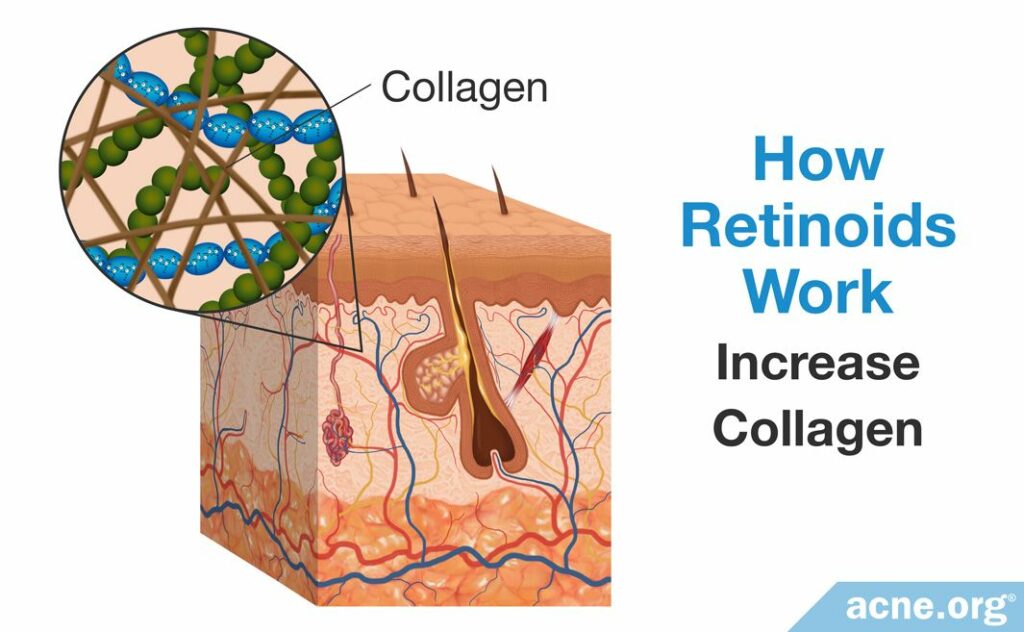
Underneath the skin’s barrier resides tissue full of structural components that support and help maintain the skin barrier. One such protein that makes up this tissue is collagen, and it is crucial in preventing wrinkle formation and smoothing skin texture.
Researchers first identified that the particular retinoid, tretinoin, increased collagen production by 80% in sun-damaged skin. The increase in collagen provides the proper support and structure for the skin’s barrier, which results in smoothing of the skin.5,7
The Effectiveness of Topical Retinoids Against Skin Aging
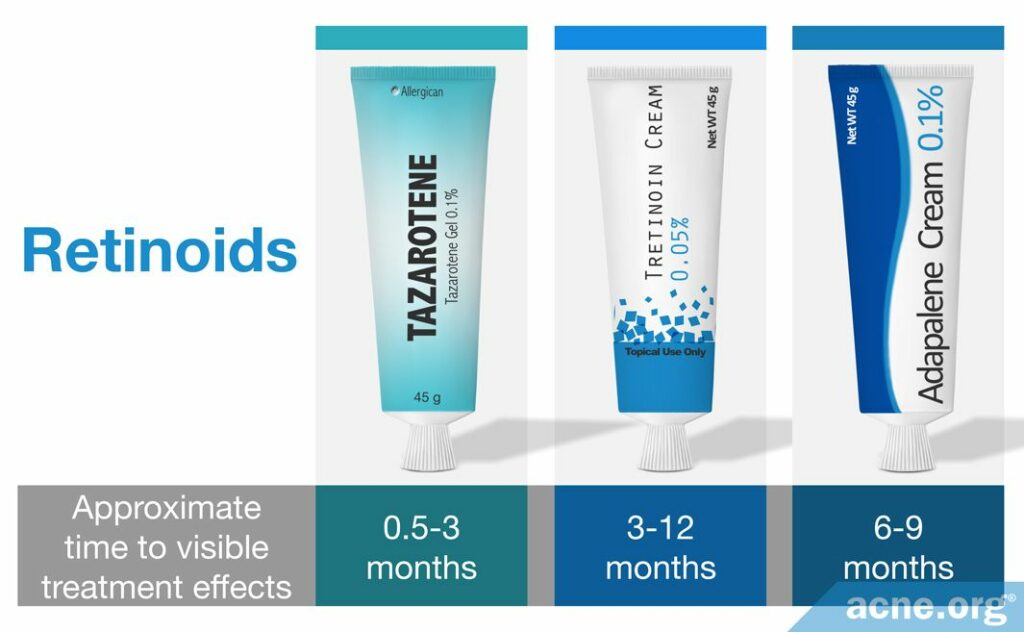
Tazarotene
Applied as a topical gel or cream, 0.1% tazarotene is generally prescribed by dermatologists to be applied nightly.
Scientists have shown that tazarotene improves a wider variety of aging symptoms than other retinoids.
In one study, scientists identified that tazarotene-treated patients reported a reduction in abnormal pigmentation after 2 weeks. By 2 months, patients reported a decrease in fine wrinkling, and by 3 months, patients reported a reduction in coarse wrinkling, skin roughness, and pore size.6
In another study, scientists compared the effectiveness of tazarotene to that of tretinoin over the course of 24 weeks. They discovered that “there was no therapeutic difference between tazarotene 0.1% cream and tretinoin 0.05% cream after 24 weeks…” However, patients receiving 0.1% tazarotene tended to respond faster to therapy, with scientists observing a larger decrease in the signs of aging at 12 and 20 weeks than with tretinoin 0.05% treatment.6
In another study, researchers looked at whether tazarotene could reduce signs of aging in photodamaged skin (skin aged by sun exposure). They found that applying a 0.1% tazarotene cream to the skin once a day for 24 weeks reduced skin wrinkling, roughness, and hyperpigmentation (dark or red spots on the skin).7
One way in which tazarotene reduced wrinkles is by causing the top layer of the skin to thicken.7,8
Tretinoin
Dermatologists often initially prescribe 0.025 – 0.05% strength tretinoin as a topical gel or cream to be applied nightly.
Research shows us that the length of time between 0.05% tretinoin treatment initiation and a reduction in signs of skin aging may be as little as 3 months, with patients reporting moderate improvements in fine wrinkles. By 6 months, patients reported a reduction in skin roughness and coarse wrinkling, and after 12 months of tretinoin treatment, scientists found an increase in the amount of collagen present in the skin of patients.7
One study compared the efficacy of 0.05% tretinoin cream and 0.3% adapalene gel for the treatment of skin that showed signs of aging due to sun damage. After 6 months of treatment with either retinoid, a little over half of the patients experienced an improvement in skin wrinkling around the eyes and on the forehead, with both tretinoin and adapalene producing similar results.9
Generally, after the first 12 months of treatment, the tretinoin concentration is decreased to 0.01%.
Adapalene
The effectiveness of adapalene in acne treatment is well-documented, but scientists have only performed 2 small trials investigating its effectiveness in the treatment of aging.
In one of these studies, scientists treated patients daily with either a 0.1% or 0.3% adapalene topical gel for 1 month, followed by application twice daily for 9 months. After 9 months, scientists observed lightening of sun-damaged areas, a decrease in crusty, thick skin patches called actinic keratosis, and wrinkles.1 The second study examined 40 females applying 0.3% adapalene gel daily for 6 months. After study completion, the patients reported a 29 – 52% reduction in facial wrinkles.11
Effects Are Short Term
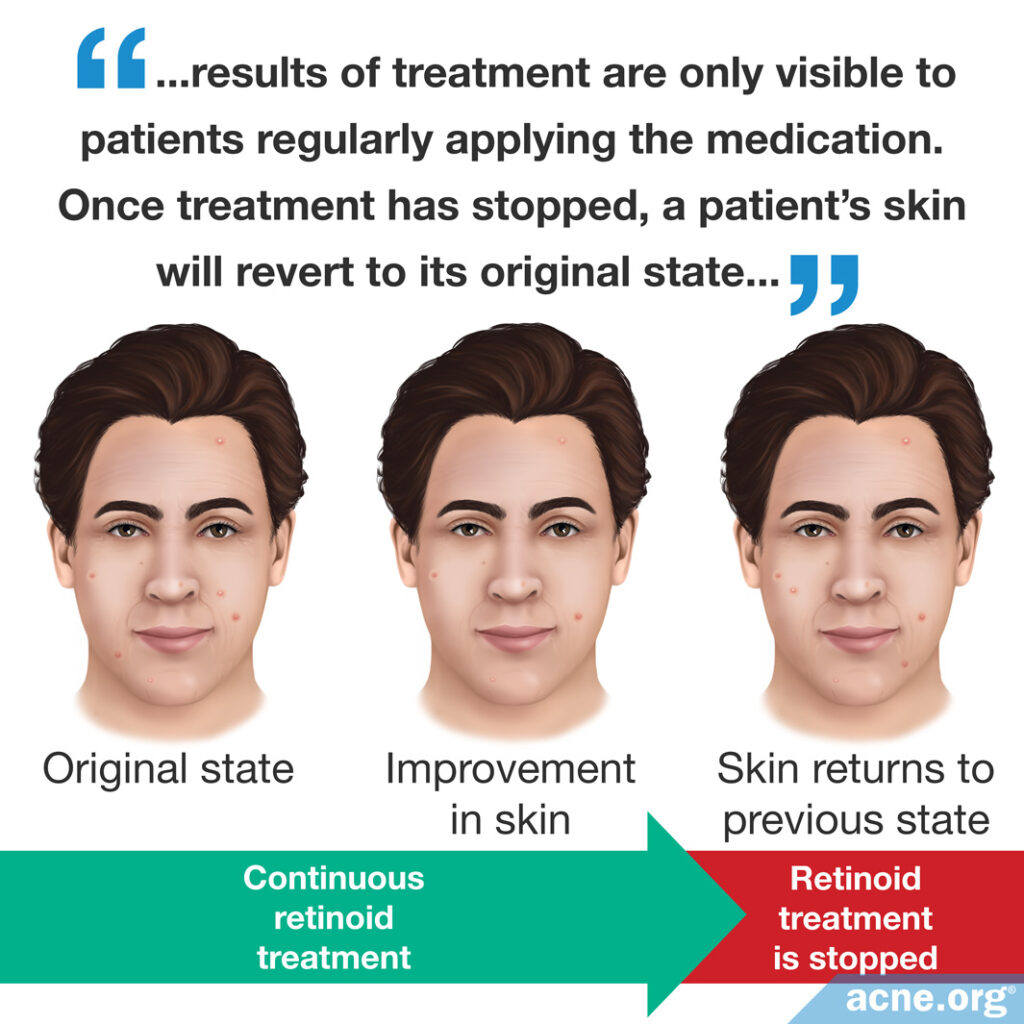
One limitation of retinoid therapy is that results of treatment are only visible to patients regularly applying the medication. Once treatment has stopped, a patient’s skin will revert back to its original state over time. Therefore, patients must continually apply retinoids to maintain younger-looking skin.10
Side Effects of Retinoid Treatment
Patients using retinoids for the treatment of aging have reported side effects. The main patient-reported side effects of retinoid treatment include:
- Skin reddening
- Irritation
- Dryness
- Itching
Side effects are often dose-dependent and resolve when patients are treated with lower doses. For example, 90% of patients applying 0.1% tretinoin cream on a daily basis exhibited these side effects. However, patients receiving a 0.025% concentration of tretinoin showed “far fewer adverse effects.”10
Researchers compared the effectiveness of lower retinoid concentrations for the treatment of aging and found that the lower concentrations provided the same anti-aging effects as the higher concentrations, but without the irritating side effects. One study compared the anti-aging effects of 0.025% tretinoin treatment to those of 0.5% tretinoin treatment over 8 months. The scientists observed no difference in the anti-aging efficacy between either concentration.10 Further, a study that observed adapalene side effects stated, “[L]ocal irritation is relatively uncommon with…adapalene… In the majority of cases, the retinoid reaction occurs early in treatment and resolves gradually.”10 Therefore, the researchers suggested that adapalene could be successfully used with lesser side effects.11
References
- Cosio, T., Di Prete, M., Gaziano, R., Lanna, C., Orlandi, A., Di Francesco, P., Bianchi, L., Campione, E. Trifarotene: A current review and perspectives in dermatology. Biomedicines 9, 237 – 253 (2021). https://pubmed.ncbi.nlm.nih.gov/33652835/
- Mukherjee, S. et al. Retinoids in the treatment of skin aging: an overview of clinical efficacy and safety. Clin Interv Aging 1, 327 – 348 (2006). https://www.ncbi.nlm.nih.gov/pubmed/18046911
- Grunebaum, L. D. & Baumann, L. S. Nonprescription topical treatments for skin rejuvenation. Facial Plast Surg 30, 3 – 11(2014). https://www.ncbi.nlm.nih.gov/pubmed/24488631
- Sorg, O. & Saurat, J. H. Topical retinoids in skin aging: A focused update with reference to sun-induced epidermal vitamin A deficiency. Dermatology 228, 314 – 325 (2014). https://www.ncbi.nlm.nih.gov/pubmed/24821234
- Milosheska, D. & Roškar, R. Use of retinoids in topical antiaging treatments: A focused review of clinical evidence for conventional and nanoformulations. Adv Ther 39, 5351 – 5375 (2022). https://pubmed.ncbi.nlm.nih.gov/36220974/
- Roeder, A. et al. Tazarotene: Therapeutic strategies in the treatment of psoriasis, acne and photoaging. Skin Pharmacol Physiol 17, 111 – 118 (2004). https://www.ncbi.nlm.nih.gov/pubmed/15087589
- Machtinger, L. A., Kaidbey, K., Lim, J., et al. Histological effects of tazarotene 0.1% cream vs. vehicle on photodamaged skin: a 6-month, multicentre, double-blind, randomized, vehicle-controlled study in patients with photodamaged facial skin. Br J Dermatol 151, 1245-1252 (2004). https://pubmed.ncbi.nlm.nih.gov/15606521/
- Ogden, S., Samuel, M. & Griffiths, C. E. A review of tazarotene in the treatment of photodamaged skin. Clin Interv Aging 3, 71-76 (2008). https://pubmed.ncbi.nlm.nih.gov/18488880/
- Bagatin, E., Gonçalves, H. S., Sato, M., Almeida, L. M. C. & Miot, H. A. Comparable efficacy of adapalene 0.3% gel and tretinoin 0.05% cream as treatment for cutaneous photoaging. Eur J Dermatol 28, 343 – 350 (2018). https://pubmed.ncbi.nlm.nih.gov/30105991/
- Hubbard, B., Unger, J. G. & Rohrich, R. J. Reversal of skin aging with topical retinoids. Plast Reconstr Surg 133, 481e – 90e (2014). https://www.ncbi.nlm.nih.gov/pubmed/24675201
- Herane, M. I. et al. Clinical efficacy of adapalene (differin 0.3% gel in Chilean women with cutaneous photoaging. J Dermatolog Treat 23, 57 – 64 (2012). https://www.ncbi.nlm.nih.gov/pubmed/22007702
 Acne.org Products
Acne.org Products